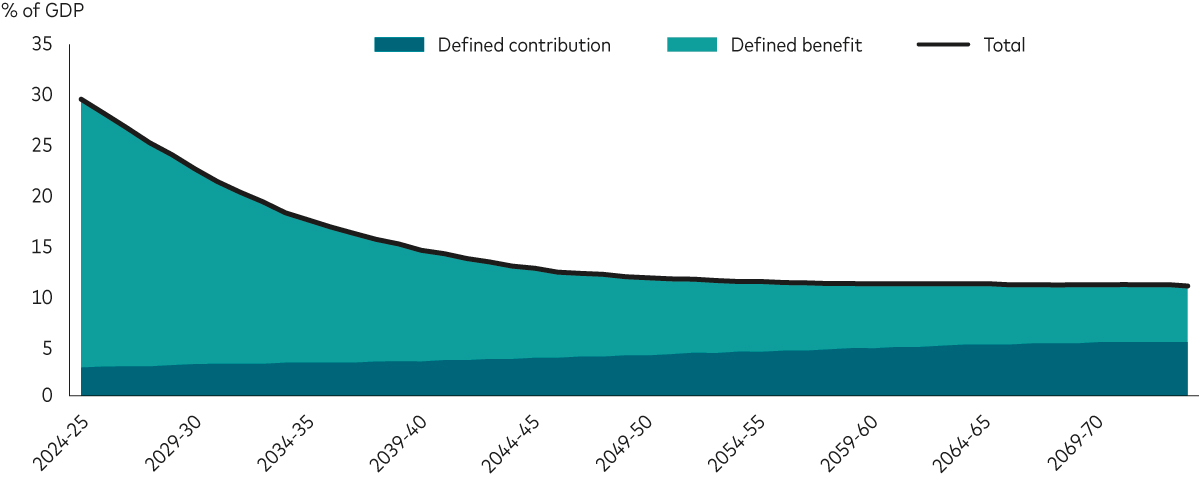- Gilts now offer more attractive returns than many other developed government bonds.
- We expect the UK economy to remain weak in the second half of 2025.
- We anticipate that the base rate will fall to 3.25% by mid-2026.
Our forecasts show that UK government bonds (gilts) offer attractive risk-adjusted returns relative to other developed fixed income markets. Over the next ten years, we expect UK gilts to generate an annualised return of 5.0%-6.0% with a volatility of 7.8% (Sharpe ratio: 0.30)1. This compares with a Sharpe ratio of 0.12 for US Treasuries2 and 0.24 for global aggregate bonds2.
Median expectation for annualised fixed income returns over the next ten years
| UK gilts | US Treasuries | Global aggregate bonds | |
| Return | 5.0%-6.0% | 3.5%-4.5% | 4.0%-5.0% |
| Volatility | 7.8% | 6.8% | 5.3% |
| Sharpe ratio | 0.30 | 0.12 | 0.24 |
Any projections should be regarded as hypothetical in nature and do not reflect or guarantee future results.
Notes: Numbers show the Vanguard Capital Markets Model forecasts for annualised return, volatility and Sharpe ratio for the period 30 September 2025 to 30 September 2028 for UK gilts (Bloomberg Sterling Gilts Index), hedged US Treasuries (Bloomberg US Treasury Index GBP Hedged) and hedged global aggregate bonds (Bloomberg Global Aggregate GBP Hedged). The return numbers are based on a one percentage point range centred around the 50th percentile of the distribution of return outcomes.
As the UK approaches its Autumn Budget in November, we outline four key drivers that we think will shape future gilt returns over the coming months and years.
1. The Autumn Budget
The UK Chancellor of the Exchequer will deliver her Autumn Budget on 26 November. She is likely to face a fiscal hole in the tens of billions of pounds following the reversal of welfare cuts and winter fuel payments, higher long-term interest rates and a likely downgrade to long-term economic growth forecasts.
Many investors expect the chancellor to plug this gap by announcing a combination of tax rises and spending cuts. This could include extending the freeze on income tax thresholds and broadening the set of VAT-applicable goods. If these announcements fall short of expectations, or are not credible, markets may worry that the government is not serious about sticking to its fiscal rules. In this scenario, gilts could underperform as investors demand greater compensation for holding bonds issued by the UK government.
2. The path for future interest rates
Since mid-2024, the Bank of England (BoE) has lowered interest rates from 5.25% to 4.00%. During this period, a similar pace of easing has been observed by the US Federal Reserve (Fed), while the European Central Bank has cut rates more aggressively.
Looking ahead, markets expect the BoE to cut interest rates more slowly than its peers in other developed markets, primarily because inflation is anticipated to fall more slowly. By the middle of 2026, investors are fully discounting only one additional interest rate cut. Compare this to the US Fed, where four interest cuts are priced in to current yields.
Higher-for-longer interest rates are constructive for gilt returns, as investors can ‘clip’ a higher coupon every six months. The risk is that inflation expectations in the UK rise further. If investors are unconvinced the BoE can get inflation down soon, they are likely to attach a higher risk premium to gilts.
3. Quantitative tightening
Since 2022, the BoE has been gradually unwinding its quantitative easing programme in a process known as “quantitative tightening”. They do this by either letting the gilts they hold mature without replacing them or actively selling them into the market. This means there are more gilts for the private sector to absorb.
Some have argued that this process is exerting upward pressure on gilt yields. Perhaps because of these concerns, earlier this month the BoE chose to slow the pace of its quantitative tightening from around £100bn a year to £70bn. Future changes to this pace have the potential to influence gilt yields over time.
4. Reduced demand from defined benefit pension funds
UK defined benefit (DB) pension funds have historically been a large and important buyer of gilts. However, according to data from the Office of Budgetary Responsibility (OBR), DB pension fund membership is set to fall, with the value of their assets expected to falling from almost 30% of GDP in 2025 to just 11% by 2074, as the chart below shows.
OBR projections for UK pension sector gilt holdings

Source: OBR Fiscal risks and sustainability report (July 2025)
This is mainly due to the winding down of private sector DB funds, which currently account for the lion’s share of pension fund gilt demand. As DB funds mature over the next 20 years they will sell increasing amounts of their gilt holdings. While defined contribution (DC) pension funds will continue to expand as they replace old DB funds, they will only be able to absorb some of these sales.
Looking ahead from a growth standpoint, the UK economy remains fragile. We expect the economy to weaken in the second half of the year, as the temporary boost from front-loaded trade ahead of US tariffs and higher government spending fades. Economic conditions are expected to be subdued into 2026, with growth expected to be below 1%. Meanwhile, we anticipate the BoE to hold interest rates at 4% for the remainder of 2025, before easing gradually to 3.25% by the end of 2026.
1 Sharpe ratio is a measure of risk-adjusted return. To calculate a Sharpe ratio, an asset’s excess return (an asset’s return minus the risk-free asset’s return, such as cash) is divided by the standard deviation of the asset’s excess return.
2 Hedged into GBP.
Related funds
Investment risk information
The value of investments, and the income from them, may fall or rise and investors may get back less than they invested.
Important information
This is directed at professional investors and should not be distributed to or relied upon by retail investors.
This is designed for use by and is directed only at persons resident in the UK.
The information contained herein is not to be regarded as an offer to buy or sell or the solicitation of any offer to buy or sell securities in any jurisdiction where such an offer or solicitation is against the law, or to anyone to whom it is unlawful to make such an offer\r or solicitation, or if the person making the offer or solicitation is not qualified to do so. The information does not constitute legal, tax, or investment advice. You must not, therefore, rely on it when making any investment decisions.
The information contained herein is for educational purposes only and is not a recommendation or solicitation to buy or sell investments.
Issued by Vanguard Asset Management Limited, which is authorised and regulated in the UK by the Financial Conduct Authority.
© 2025 Vanguard Asset Management Limited. All rights reserved.
